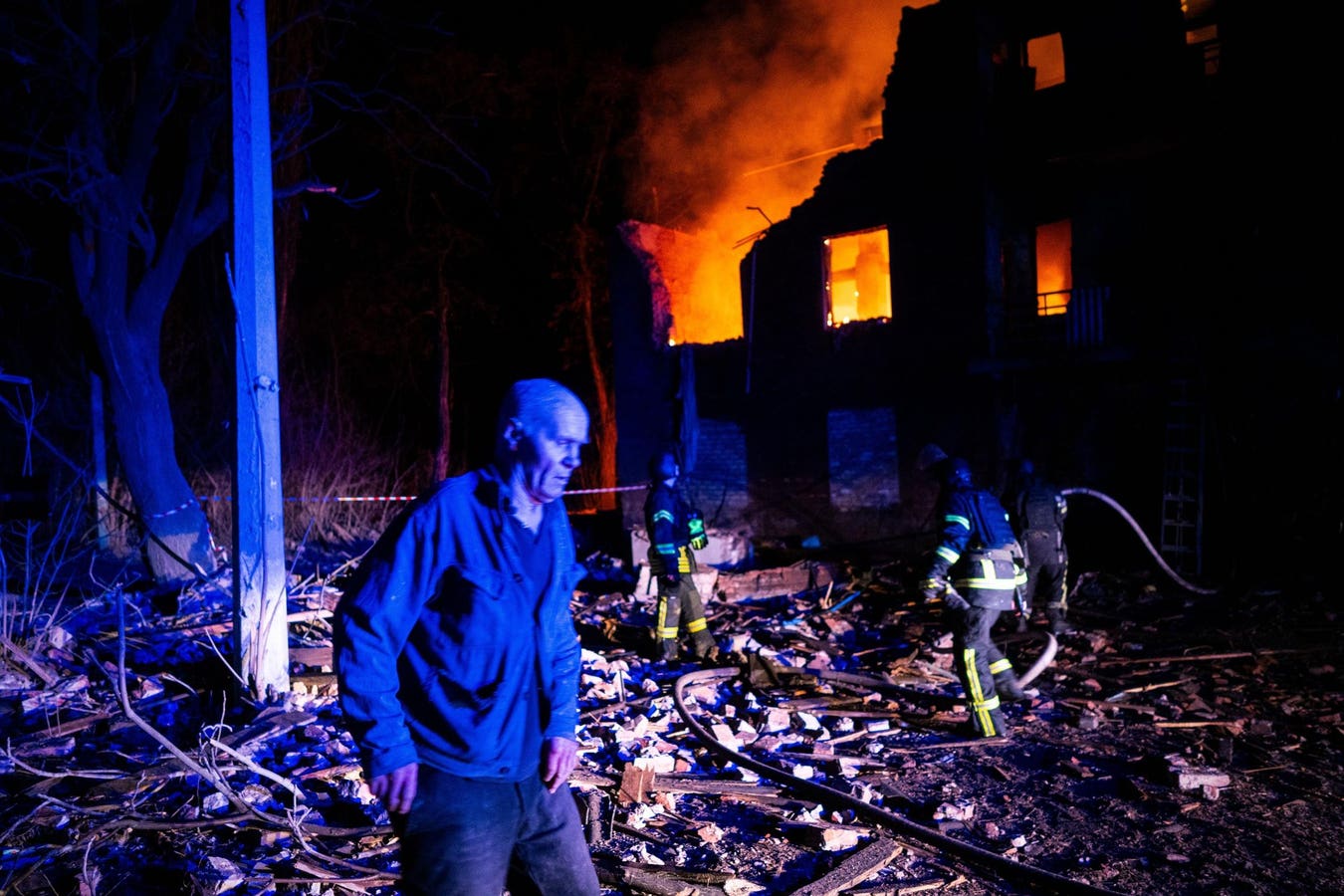KRAMATORSK, DONETSK OBLAST, UKRAINE – JANUARY 03: A view from the area where a residential building … [+] in Kramatorsk, Donetsk Oblast, Ukraine hit by a Shahed drone, leaving extensive damage on January 3, 2025. Firefighters rushed to the scene, battling the flames in the aftermath of the strike. (Photo by Vincenzo Circosta/Anadolu via Getty Images)
Anadolu via Getty Images
Dispatches from Ukraine. Day 1,049
Kherson region. On Jan. 6, Russian forces launched artillery, mortar, and drone strikes on localities in Ukraine’s southern region of Kherson, killing two civilians and wounding 11 others, local authorities reported.
Donetsk region. Russian troops executed three Ukrainian prisoners of war near the eastern front line on Jan. 3, the Ukrainian parliament’s commissioner for human rights Dmitro Lubinets announced, citing the war monitoring project DeepState. The soldiers, who had surrendered during a battle, were reportedly tied up, led in front of Russian positions in the small town of Neskuchne, and shot in the back of the head. Lubinets, along with human rights groups, condemned the act, accusing Russia of systematic abuse of Ukrainian POWs.
Dnipropetrovsk region. On Jan. 5, Russian artillery struck the industrial city of Nikopol in the country’s southeast, killing a 43-year-old man.
Despite Ukraine halting the transit of Russian natural gas through its territory, Russia will likely be able to mitigate the negative impact on its economy by selling more to Asian markets and boosting its LNG (liquid natural gas) exports, with losses projected at just 0.2–0.3% of GDP, according to Bloomberg. Europe continues to buy record amounts of Russian LNG, while Russian pipeline exports to China hit a record 31 billion cubic meters (bcm) in 2024 and are expected to rise to 38 bcm when the Power of Siberia pipeline reaches full capacity in 2025. Russia’s state-owned energy giant Gazprom may also boost sales via the TurkStream pipeline and redirect gas to Central Asia. Russia aims to triple LNG exports to 100 million tons by 2035, though sanctions may jeopardize these plans.
More than 1,000 North Korean troops have been killed or wounded fighting in Russia’s Kursk region, U.S. Secretary of State Antony Blinken said on Jan. 6. As both Russian and Ukraine step up offensives ahead of U.S. President-elect Donald Trump’s return to the White House, fierce fighting continued in Russia’s Kursk region for the second day, where Ukraine’s forces have gained and held ground, potentially positioning for leverage in future peace talks.
Meanwhile, the Kremlin reported significant advances in eastern Ukraine, claiming the capture of Kurakhove, a small town with a pre-war population near 20,000, bolstering Moscow’s push toward the strategic logistics hub of Pokrovsk in the eastern oblast, or region, of Donetsk. Officials in Kyiv acknowledged ongoing battles in Kurakhove, but stopped short of confirming its fall.
A recent poll by the Kyiv International Institute of Sociology shows a shift in public sentiment, with 38% of Ukrainians now considering territorial concessions acceptable to achieve peace with Russia, up from 32% in October. While regional variations show slight increases in support for territorial concessions, a majority of Ukrainians still reject such compromises. Yet, the percentage of those strongly opposed to any territorial compromises has dropped to 51%, down from 58% in the fall.
Ukraine’s agricultural exports soared to $24.5 billion in 2024, accounting for almost 60% of the nation’s total exports and marking the second-highest performance, after 2021’s record $27.7 billion. The country exported 78.3 million metric tons of agricultural products, led by sunflower oil, corn, and wheat. Overall, Ukraine’s exports rose 15% year-over-year to $41.6 billion, with maritime trade surging to 87.2 from 54.8 million metric tons in 2023, reinforcing Ukraine’s position as a global agricultural export powerhouse.
Russia has abolished one-time payments to prisoners recruited to fight in Ukraine, signaling mounting financial pressures amid the ongoing war, according to Ukraine’s Foreign Intelligence Service. The bonuses, which ranged from $1,700 to $3,500 in 2024, were eliminated as of January 1, leaving incarcerated recruits and their families without the financial benefits enjoyed by other combatants. By November 2024, Russia had mobilized 140,000–180,000 prisoners in its war against Ukraine, a significant portion of its shrinking prison population, which has dropped by half since 2014, likely due to war recruitment.
In a wide-ranging three-hour interview with podcaster Lex Fridman on Jan. 5, Ukrainian President Volodymyr Zelenskyy discussed critical issues, including the potential end of the war, NATO membership and security guarantees. Zelenskyy emphasized that initial peace talks would be with U.S. President-elect Donald Trump, followed by Russian discussions, with hopes of securing strong security guarantees for Ukraine, potentially through NATO membership. He proposed using $300 billion in frozen Russian assets to purchase American weapons, underscoring that Ukraine doesn’t need handouts, but rather a financial stake in its defense. Zelenskyy also indicated that elections in Ukraine could only be held after the war ends or if legislative changes are made. He also stated that North Korea had lost 3,800 soldiers fighting for Russia and reiterated the need for Ukraine to negotiate from a position of military strength with Russian President Vladimir Putin, whom he described as deaf to diplomatic efforts.
By Danylo Nosov, Karina L. Tahiliani
